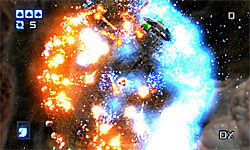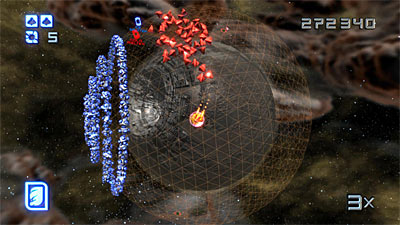Entering the Third Dimension
January 20, 2010 – Clearly, the biggest attraction being showcased at this year’s CES was the spread of 3D technology. If there was any part of a booth that had anything to do with visual output for home entertainment, chances are pretty high that the third dimension was somehow involved. Though walking around the show floor mostly provided glimpses of 3D video and new 3D-ready high-def TVs, games made a showing as well.

Nvidia had various displays around the show floor, showing off revamped versions of Gears of War 2 and Resident Evil 5 (among other games) running in full stereoscopic 3D using only specialized wireless glasses and software that modifies a game’s existing code (which frankly almost makes me wish I had a suped-up gaming rig); Microsoft went for the decidedly low-tech approach with Scrap Metal’s old-school-theater blue-and-red 3D showing, and Sony had their own showing of mostly first-party titles, with the likes of Killzone 2, LittleBigPlanet, and Gran Turismo 5 getting shown on 3D-ready Bravias, using Sony’s own wireless shutter glasses.
With all the console heavy hitters Sony was showing off in 3D (admittedly most of these were featured on a non-playable preview reel), the logical conclusion would be that one of them would make the best use of the new tech, but that wasn’t the case. Instead, the best example of console 3D-tech at the show came from a title far more quaint in comparison: Sony’s 2007 PSN shooter Super Stardust HD. As a relatively early addition to the PlayStation Network, Super Stardust HD received high marks for its simple-yet-fun Asteroids-style dual-analog shooting and colorful high-res visuals. The version I played at CES was, as near as I could tell, exactly the same game as has been available for download for over two years, only retrofitted with 3D effects via an upcoming PS3 firmware release.
So, why did Super Stardust HD’s 3D showing draw such universal acclaim from CES showgoers? There are a couple of reasons. First, the game runs at 720p, setting it apart from many other 3D console titles that use lower resolution tricks to create dimensional depth of field effects. Second-and this is the important part-Housemarque, the developer behind Super Stardust HD, worked especially hard on revamping their game’s visuals for three dimensions, essentially doubling the amount of rendered frames on screen. The result is that when you’re wearing the 3D shutter glasses, the game appears in a whopping 60 FPS per eye. While the technical details on how doubling the frames per second actually helps to create a 3D effect elude me, let me assure you, the results are nevertheless astounding.

If you’ve ever played Super Stardust HD, you already know its clean, crisp visuals are quite attractive (particularly for a two-year-old PSN title), and actually playing it in 3D only makes them more dazzling. The dev team actually took advantage of adding 3D effects to gameplay in ways that other games can’t-whereas most games merely improve depth of field in a way that really contrasts levels of distance, Super Stardust HD renders objects that interact with them, moving from the back or middle of the screen to a distance relative to your eyes. To put it simply, when you’re blasting out chunks from a hunk of space rock, shards of the rock break off, spinning and floating (with realistic physics) in a cluster clearly showing which pieces are closer or further away to you. Similarly, if an asteroid (or your ship) explodes, rock or metal debris will even fly out, literally exploding in front of you. It may be needless to say, but the Super Stardust HD’s particle effects are topnotch.
The game’s depth of field is improved as well, with your ship hovering at a distance above the planet, whose wireframe core is spatially further away from either ship or any blasting material that may happen to be nearby. The game’s weapons also fire above the planet’s surface, in logical spatial relation to your ship. The effect of seeing them appear “from space” rather than simply on the planet’s surface is a subtle but very effective use of the tech, and you can almost picture the sci-fi battles taking place in a to-scale environment showing distance from space to the planet below. The flamethrower effects are particularly notable when they’re chewing through a meaty group of asteroids.

It’s clear that 3D games are still in their infancy. Super Stardust HD looked amazing, but didn’t add any depth-perceptive 3D mechanics to its core design, for example. However, for a game design relative to popcorn thrills, the visual really did the trick. It will be interesting to see exactly how developers start utilizing 3D in future games-particularly since not every game, at least for the PS3, will have the necessary processing resources to render twice as many frames per second as normal-but for just a simple retroactive visual improvement, Housemarque has really taken a great first step. I guess James Cameron was right-now he can take some pride in the fact that we are, in fact, living in a post-Avatar world.
Game Features:
